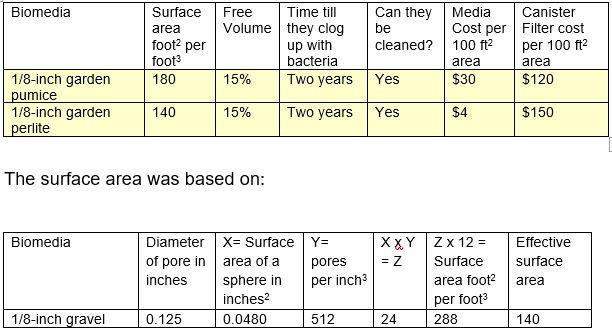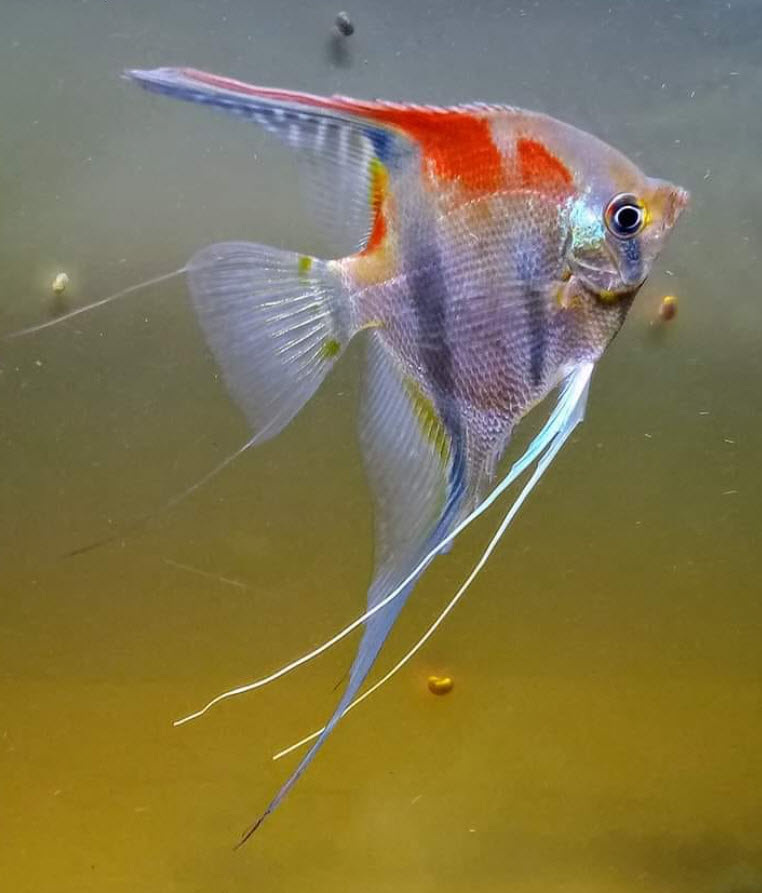Pumice is a form of natural volcanic rock where a very low viscosity lava shot to the Earth’s surface full of gas. The gas expanded rapidly at the surface before the molten rock could cool. The rock thus became a very lightweight foam. This foam is dug up, crushed and sorted to various sizes.
The data from the master table for pumice and perlite was:


Pumice is what is called a “closed cell foam”. It is impossible for water to get inside of a piece of pumice. Thus pumice floats. There are undersea volcanoes in the Pacific which produce volumes of pumice from time to time. The floating pumice can end up on beaches far away.
The surface of pumice is a whole bunch of small vesicles with about the same size as a 45 ppi foam. Pumice biomedia will trap a thick film of beneficial bacteria in its rough and convoluted surface.
Perlite is made from a form of rock with dissolved water in it. The raw rock is heated to its melt temperature and the rock then expands. Perlite is similar in properties to pumice except its surface is smooth. This smooth surface does mean perlite has a lower effective surface area than pumice.

Agricultural, bonsai or garden pumice and perlite are cheap and easily purchased in large quantities over the internet.
Pumice and perlite floats. This means pumice and perlite need to be confined in the filter if the pumice or perlite is to remain submerged. This can limit the use of pumice and perlite. Because they float they are difficult to keep in a gravity submersed filter such as a sump and they have a nasty habit of ending up in everything, including the aquarium.
An easy way around this floating is to put the perlite or pumice in nylon mesh laundry bags at roughly 50% loading of the bags. These bags can be tightly sealed and put in something like a sump, conforming to the contours easily. A light “milk crate diffuser” or plastic needlepoint framework can be placed on top and a heavy media placed on the top (something like clay balls) to weigh everything down and keep it in the sump when water enters.
But the perlite will have some small particles which will work their way out of the mesh bags. One will never get all the perlite particles out of the aquarium. You’ll keep finding them for years. This is a big problem.

There is one decided downside to both pumice and perlite. Both media constantly shed very tiny invisible highly abrasive particles. These particles work their way into the magnetic drives on aquarium pumps and wear them out rapidly. I’m not fond of frequently replacing pump impellers.
Er werd een test uitgevoerd van het ammoniak-oxiderende vermogen van verschillende filtermedia. Het eerste cijfer, de "efficiëntie", is de gemiddelde ammoniakoxidatie die 15 kubieke inch medium gedurende een periode van 90 dagen heeft bereikt. Het tweede getal is het "effectieve" oppervlak in vierkante voet per kubieke voet berekend op basis van die test. Het derde getal is het effectieve oppervlak in vierkante voet per kubieke voet berekend door eenvoudige wiskunde. De correlatie tussen de testresultaten en het berekende oppervlak is zeer significant en betekent dat de testen nauwkeurig waren.
| Media | “Efficiëntie” uit twee testen | "Effectief" oppervlakte ft²/ft³ | ft²/ft³ uit berekening | "Effectief" oppervlakte m²/m³ | m²/m³ uit berekening |
|---|---|---|---|---|---|
| Bewegend K1 media | niet getest | 600 | Niet beschikbaar | 1980 | Niet beschikbaar |
| 30 PPI-schuim | 17 | 340 | 400 | 1122 | 1320 |
| Pannenspons | 14 | 280 | 80 | 924 | 264 |
| Statische K1 media | 13 | 260 | 200 | 858 | 660 |
| 20 PPI-schuim | niet getest | 220 | 180 | 726 | 594 |
| Aquarium grind | 6 | 120 | 120 | 396 | 396 |
| Blauwe Matala-pads | 5 | 100 | 120 | 330 | 396 |
| Eshoppe bioballen | 5 | 100 | 60 | 330 | 198 |
| ¼ tot ½ inch lavastenen | 3 | 60 | 60 | 198 | 198 |
| Matrix | 3 | 60 | 30 | 198 | 99 |
| Biohome ultimate | 2 | 40 | 30 | 132 | 99 |
| Keramische ringen | 2 | 40 | 40 | 132 | 132 |
| * gemiddelde ammoniak die 15 kubieke inch (245,81 cm³) medium oxideerde gedurende een periode van 90 dagen | |||||
The higher the numbers here the better the media. While pumice and perlite weren’t tested, the results for pumice and perlite at a size of 1/8 to 1/4 inch of perlite or pumice will probably give results very close to that of the aquarium gravel.
Given that neither pumice or perlite are probably no better at biofiltration than aquarium gravel of the same size I don’t know why one would buy all the problems associated with these two materials. Just use aquarium gravel. Gravel gives no floating particles and no abrasive particles. Better yet buy the fused clay product sold as oil absorbents in automotive stores and Tractor Supply. It is cheaper than gravel.



